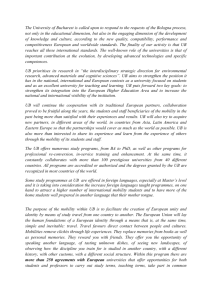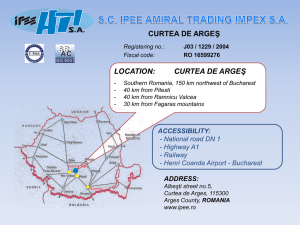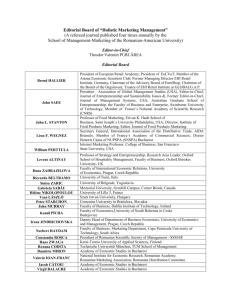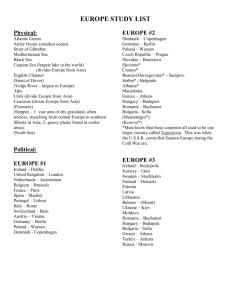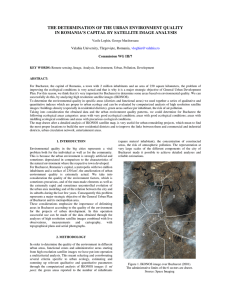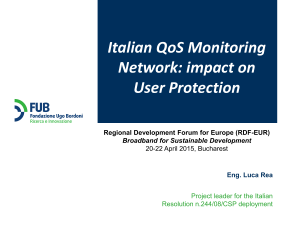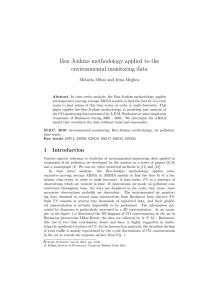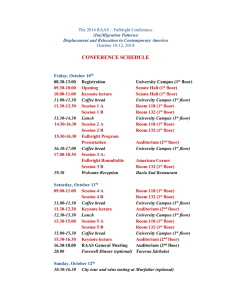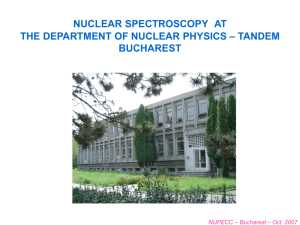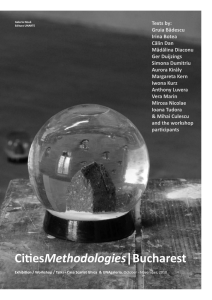Bucharest: Population dispersion and air polution
advertisement
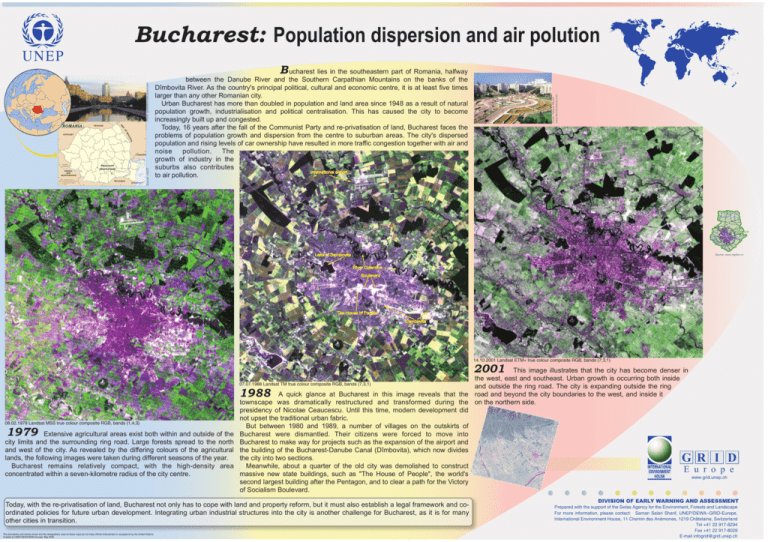
Bucharest: Population dispersion and air polution 23° ROMANIA 27° 25° 29° R UKRAINE EP 48° F .O MO LD HUNGARY 47° t OV Pr u 47° A 46° Prut 46° D an Beograd (Belgrade) Bucuresti (Bucharest) Ialo Danub SERBIA AND MONTENEGRO e 45° m it a BLACK SEA ub e Dan 44° National capital International boundary Provincial boundary River ub BULGARIA 23° 25° 27° 0 0 50 25 44° 100 km 29° 50 mi Source: UNCS 45° UKRAINE between the Danube River and the Southern Carpathian Mountains on the banks of the Dîmbovita River. As the country's principal political, cultural and economic centre, it is at least five times larger than any other Romanian city. Urban Bucharest has more than doubled in population and land area since 1948 as a result of natural population growth, industrialisation and political centralisation. This has caused the city to become increasingly built up and congested. Today, 16 years after the fall of the Communist Party and re-privatisation of land, Bucharest faces the problems of population growth and dispersion from the centre to suburban areas. The city's dispersed population and rising levels of car ownership have resulted in more traffic congestion together with air and noise pollution. The growth of industry in the suburbs also contributes International airport to air pollution. Photo: Tatiana Murzin www.aboutromania.com Photo: goeasteurope.about.com B ucharest lies in the southeastern part of Romania, halfway Lake of Dambovita Source: www.rapitori.ro River Colentina Boulevard The House of People Dambovita 14.10.2001 Landsat ETM+ true colour composite RGB, bands (7,3,1) 2001 This image illustrates that the city has become denser in the west, east and southeast. Urban growth is occurring both inside 07.07.1988 Landsat TM true colour composite RGB, bands (7,3,1) and outside the ring road. The city is expanding outside the ring A quick glance at Bucharest in this image reveals that the road and beyond the city boundaries to the west, and inside it townscape was dramatically restructured and transformed during the on the northern side. presidency of Nicolae Ceaucescu. Until this time, modern development did not upset the traditional urban fabric. But between 1980 and 1989, a number of villages on the outskirts of Bucharest were dismantled. Their citizens were forced to move into Bucharest to make way for projects such as the expansion of the airport and the building of the Bucharest-Danube Canal (Dîmbovita), which now divides the city into two sections. Meanwhile, about a quarter of the old city was demolished to construct E massive new state buildings, such as "The House of People", the world's second largest building after the Pentagon, and to clear a path for the Victory of Socialism Boulevard. 1988 08.02.1979 Landsat MSS true colour composite RGB, bands (1,4,3) 1979 Extensive agricultural areas exist both within and outside of the city limits and the surrounding ring road. Large forests spread to the north and west of the city. As revealed by the differing colours of the agricultural lands, the following images were taken during different seasons of the year. Bucharest remains relatively compact, with the high-density area concentrated within a seven-kilometre radius of the city centre. Today, with the re-privatisation of land, Bucharest not only has to cope with land and property reform, but it must also establish a legal framework and coordinated policies for future urban development. Integrating urban industrial structures into the city is another challenge for Bucharest, as it is for many other cities in transition. The boundaries and names shown and the designations used on these maps do not imply official endorsement or acceptance by the United Nations. Created at UNEP/DEWA/GRID-Europe; May 2005 G R I D u r o p e www.grid.unep.ch DIVISION OF EARLY WARNING AND ASSESSMENT Prepared with the support of the Swiss Agency for the Environment, Forests and Landscape For more information, please contact: Saman Salari Sharif, UNEP/DEWA~GRID-Europe, International Environment House, 11 Chemin des Anémones, 1219 Châtelaine, Switzerland Tel +41 22 917-8294 Fax +41 22 917-8029 E-mail infogrid@grid.unep.ch


